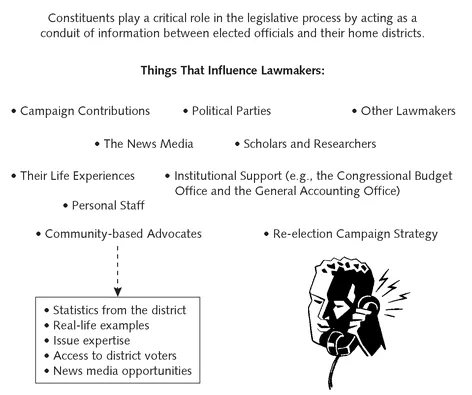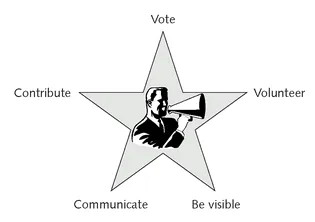![]()
PART 1
Gather Information and Strategize
![]()
ACTION 1
Learn How Grassroots Advocacy Works
In this chapter, you will learn: • How grassroots advocacy works
• Why voting is not enough to win on your issues
• Why where you live determines your political strategy
• Eight important grassroots concepts
• What “staying on message” means and why it is imperative
Our government is extraordinarily fragmented for reasons that you probably cherish. Putting lots of people from lots of different districts in charge of our government seems to have been an effective way to guard against too much power being concentrated in the hands of any one individual.
Our government has ingeniously avoided this problem for a couple of hundred years by fracturing power into an almost indefensible number of little pieces. We may have a president of the United States, but the president must rely on Congress to pass laws. And what does the Congress consist of? A couple of close confidants? No. A committee of ten expert advisers? No. A couple dozen of the richest or smartest people in the land? No. The Congress currently consists of 535 publicly elected officials who, more or less like the president, feel that they are to some extent in charge of the governance of our country. The Congress is divided into two chambers: the House of Representatives (435) and the Senate (100). The executive and legislative branches of our federal government are in turn kept in check by the Supreme Court, yet another body with an assortment of powers.
And that’s just the federal government. You probably have a state government that is organized in a similar, highly fragmented fashion. Then there’s a local or city government that also governs you. If it sounds hopelessly convoluted, you are beginning to get the idea.
Our country has the sort of organizational chart that would mar any CEO’s sleep with fitful starts, yet your freedoms depend on this arrangement. The inherent confusion of the American system of government helps deter our elected officials from the evil expressions of power that a more efficient system of government would facilitate.
All of these little pieces of power are divided up into legislative districts according to geography, and the registered voters who live in each district generally get to elect their representatives. This seems a fair way to divide influence, but it has another benefit. So many people from so many different places get elected to run our country that a broad number of stakeholders—not just people from different political parties—but people from far-flung places with different economies, different experiences, different lives—are potentially involved in the governance of our country. In addition to their own differences being brought to bear on the questions of the day, our representatives risk losing their power on Election Day if they do not satisfactorily reflect the needs, goals, and ideas of the different groups that live within the different districts they represent.
In practice, the structure of our government results in a number of frustrations. First, the need for compromise is beyond question in U.S. politics because there are too many stakeholders affected by any proposed law to keep it pure. Another drawback is that resolving the various conflicts created by a multitude of interested parties can make the actual process of crafting legislation convoluted and time-consuming. You probably already knew that. Some lament this, but a government characterized by the unanimous embrace of extraordinarily simple solutions to public problems is called a dictatorship, and you do not want that.
If passing legislation in this country were quick and straightforward, ice cream would have been outlawed long ago—and there would be even more serious curbing of our freedoms. I can’t think of any just now, but that ice cream report was pretty scary.
In the end, the structure protects us, but it does not guarantee that the actual governance will be high quality. Our government merely offers promise. Actual governance is left up to those in power and those who choose to participate in the process (see Illustration 1.1).
Illustration 1.1. The Federal Legislative Process and the Role of Constituents
THE GRASSROOTS STAR OF INFLUENCE
There are five main reasons that an elected official would want to do your bidding: voting, contributing, volunteering, visibility, and communication. These five characteristics form the grassroots star of influence (see Illustration 1.2).
• Voting. This is the most important and most basic of the reasons that an elected official would want to pay attention to you. In most cases, being a constituent obviates the need for a lengthy or technical discussion or debate related to your issues. It is not that your legislators are not interested in the substantive provisions in any piece of legislation, but they usually have staff who can help them understand what a bill might do. What your legislator does not know is if any particular piece of legislation is a priority to her voters—a priority for passage and a priority for the limited amount of funding that the government can provide. If you say a bill is a priority and you are a voter, then it becomes a priority. No amount of campaign funding can supplant the power you have as a voter to help determine the legislative priorities for your district. (See Part Three.)
• Contributing. In addition to votes, it takes a lot of money for elected officials to run for office and then to run for reelection, and there is no indication that things are going to change anytime soon. This means that elected officials must constantly be chasing campaign contributions—and the easiest way for them to do that is by keeping the people who have already given them money happy. If you are a campaign contributor, you are important to your elected officials. (See Part Three.)
Illustration 1.2. The Grassroots Star of Influence
• Volunteering. A third way to get the ear of a current or potential legislator is to volunteer for a candidate’s campaign. Labor is very expensive, and most electoral campaigns are starved for cash. That means that people who volunteer often become part of a close, extremely valued circle of supporters who do the heavy day-to-day lifting of putting (or keeping) a candidate in office. Volunteers are seldom forgotten. (See Part Five.)
• Visibility. Elected officials are sometimes attracted to people with high visibility. People who are highly visible often represent or influence their own constituency of voters and contributors as opinion leaders in their communities. If the president of the local university, for example, is vocal in her support of the governor, that support might generate a large number of votes for the governor. The governor would do well to learn the issues and positions that are important to the president of the university. (See Part Four.)
One-Hour Rule
Grassroots success relies on three things: where you live, how you communicate, and if people in other districts are asking for the same thing.
• Communication. If you are a voter, a campaign contributor, a volunteer, or a community leader, then your elected officials want to make you happy, but they cannot read your mind. They depend on you to communicate your general areas of interest on the campaign trail and to substantively inform them about specific legislation when they are in office. Many people assume that legislators are interested in counting letters or phone calls related to an issue and do not really care to delve into individual stories or arguments. This is not true. Elected officials need anecdotal, local stories to make the statistics related to a particular initiative come alive. Local arguments and stories are both welcome, even sought after, by elected officials. Such communications form the backbone of high-quality grassroots actions as opposed to low-quality actions (like preprinted postcards and petitions) that focus being counted in a legislative office without attempting to establish a substantive exchange with your lawmakers.
WELCOME TO THE GRASSROOTS DRIVE-IN
Cultivating an ongoing relationship with your elected officials is the best way to serve the issues you care about over the long term, but your efforts alone do not determine grassroots success. Ultimately, your efforts must be mirrored by advocates across a large number of districts in order to have a federal, state, or local government pass the bills you care about.
This is how it works. Picture your larger struggle for success as a trip to the Grassroots Drive-In, where the feature film is The Grassroots Success Story.
You want as many elected officials as possible to see this movie, and you have a little two-seater convertible. But you’ve got only one extra seat in your convertible, so you can invite one and only one lawmaker to come to the drive-in with you. No matter how hard you try (and don’t even think about the trunk), you can bring one and only one representative in with you. Once inside the drive-in, your lovely convertible will take up one and only one parking space. (This scenario is sketched out in Illustration 1.3.)
The problem is that The Grassroots Success Story will not be shown until at least half of the parking spots are filled. You take up only one spot in the parking lot. How do you get the other available parking spots filled with legislators? Other people with other two-seater convertibles have to convince their legislators to come to the drive-in in their cars until enough of the parking spots are filled.
The reason you have a two-seater convertible is that for almost every legislative battle, you will have one and only one elected official who represents your interests. (You have two legislators in the U.S. Senate, but let’s keep it simple for now.) No matter how hard you try, it is almost impossible to make any elected official other than the one who officially represents you care about your requests. This is both an advantage and a disadvantage. The advantage is that you are the key to bringing your elected official to the Grassroots Drive-In. No one who lives outside the district will be more persuasive than you. The disadvantage is that you must rely on advocates from other districts to convince their own legislators to vote your way.
Illustration 1.3. Welcome to the Grassroots Drive-In
Each parking space at the drive-in stands for a single district represented by an individual legislator. More than half of the spaces need to be filled for the movie to begin because a majority vote at any level of government is generally required to advance legislation. Efforts must be coordinated for the grassroots to have a real impact on the fate of a particular piece of legislat...




